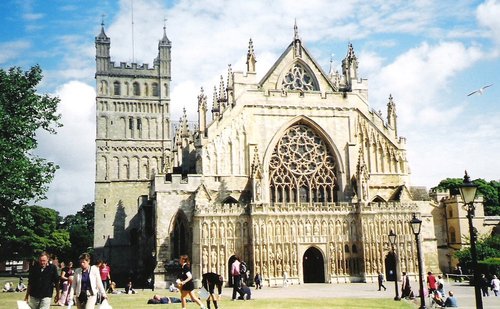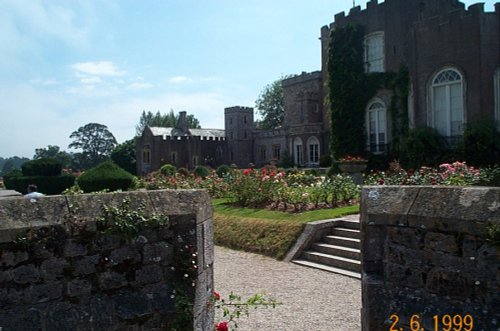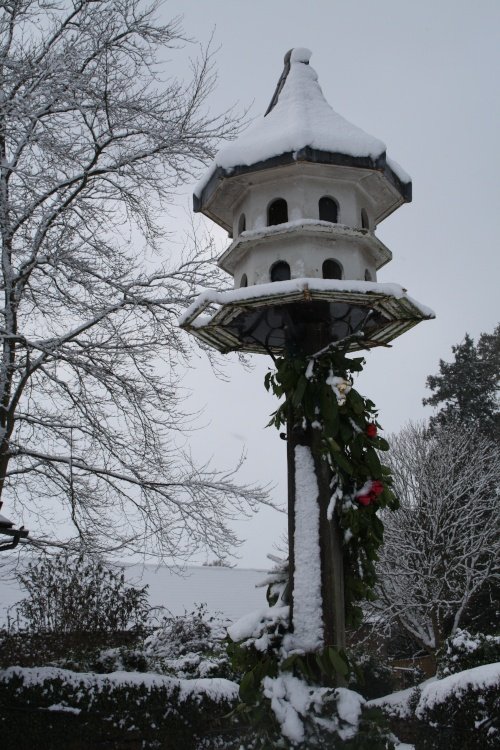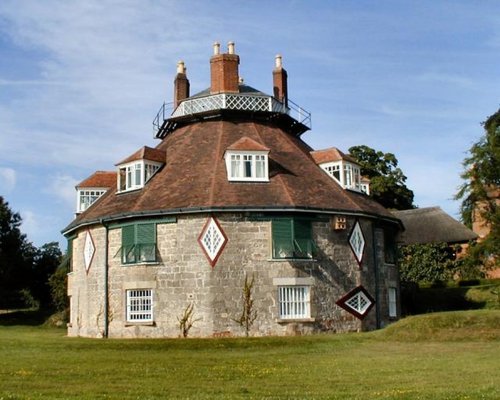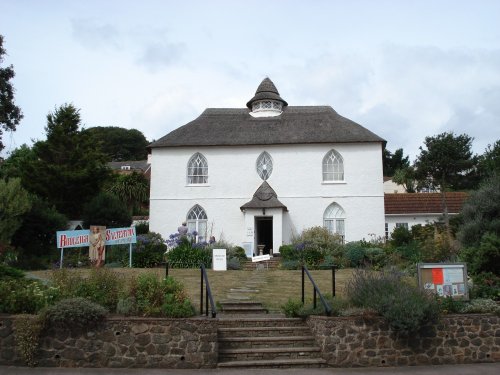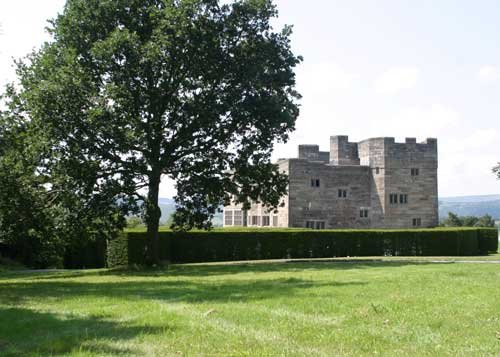Pictures of Exeter
About Exeter
Exeter is a bustling city in the heart of the county of Devon. It's mix of modern and functional with old and cultural makes for an interesting place to live, and to visit. The population of around 110,000 people are generally a happy and friendly bunch, and will make you welcome wherever you go. As well as history, there's a good selection of shops, plenty of watering holes, hotels, restaurants and leisure activities on offer - with all good cities - something for everyone.
Virtual Walk
One of the best ways of showing what Exeter has to offer is to take you on a "virtual walk" around the City, so we'll start where many will arrive, at St. David Station. You'll first be greeted with a handful of pubs, all well placed for the weary traveller, including the Great Western Hotel, but carry on up St. David's Hill and into College Road, you will pass St. David's Church, Burty Meadow and the prominent Buller Statue. Head towards the town, past the Clock Tower, and into Victorian Queen Street. Walk along further past the prominent Thistle Hotel, and Central Station. To your left you should see the entrance to Northernhay Gardens, we'll stop here for a while.
This is said to be the oldest public open space in the whole of England, originally laid out in 1612 as a pleasure walk for Exeter residents. Much of Northernhay gardens now represent Victorian design, with a beautiful display of trees, mature shrubs and bushes and plenty of flower beds. The area is also where many statues are situated, most importantly the War Memorial by John Angel and the Deerstalker by E.B.Stephens. The Volenteer Memorial from 1895, also in the gardens commemorates the formation of the 1st Rifle Volunteers in 1852. Other statues include John Dinham and Thomas Dyke Ackland.
Passing through a gate in the wall in the centre of the gardens will lead you the 18th Century Rougemont (meaning "Red Hill") Gardens which are set below the walls of the castle, where part of the moat lay, but is now completely dry. The inner bailey of the large stone ringwork Castle was built in 1068 under the instruction of William the Conqueror to defend this important town. The area of Rougemont is a natural volcanic peak. The building of the castle was due to an 18 day siege, and William put Baldwin de Brionne, his Sheriff of Devon in charge of defence. Some skill and plenty of thought must have gone into it as it gives an extensive view, not only of the City, but also the river and as far as the sea, almost ten miles away. The only means of entrance to the castle would have been a drawbridge. All that remains of the castle today is the early Norman Gatehouse, one of the earliest pieces of Norman building work to survive in the whole of England, and Athelstans Tower. At the foot of the gatehouse are some canons stamped "Spanish Armada" 1588. This tower was constructed in the late 12th century, not by King Athelstan who was the first son of Edward the Elder and reigned between the years of 925 and 940. The Norman gatehouse was 2 stories high, with extremely small windows, the walls 6 feet thick and featured an inner and outer door, each with a 12 foot archway.
The gatehouse was defended in the year 1126 by Baldwin de Redvers. King Stephen tried all sorts to take the castle but failed and the garrison only surrendered, after 3 months, due to lack of water. Baldwin and his men were allowed to march out with the honours of war by his Barons, obviously thought highly of their gallantry. Baldwin then retired to the Isle of Wight where he began attacking merchants in the pirate fashion.
Exeter was beseiged several times later, but, each time the city and castle were held. A large amount of armour was kept in the Castle, and was last used during the Civil War. It was stored until about 1800 when Colonel John Simcoe took it to Somerset. The armour was brought back to the museum in the 1870's.
For many years the castle's yard was used as a gathering place, however the fine Georgian Assize County Courts built in 1774 now occupy the inner part of the castle so this is no longer possible. The courts will move to new buildings in the future so that the castle and yard be accessible for all to see.
Also in the grounds of Rougemont Gardens, just opposite the gatehouse is Rougemont House, built by John Patch, an Exeter surgeon in the 1700's. It was later changed to a more regency style architecture by Edmund Granger in 1810. The building was purchased by Exerer City Council in 1911, and is currently used as a Discovery Centre.
A plaque near the gatehouse reminds us of the times of witchcraft and hangings in the late 1600's. Executed in Exeter after being found guilty for witchcraft were Temperance Floyd, Mary Trembles and Susanna Edwards on 18th August 1682. Susanna and Mary wept on the way to the gallows while Temperance apparently did not seem to care. In 1685 Alice Molland was the last execution for witchcraft in England.
Moving on from the gardens, head further up Queen Street where you should visit The Royal Albert Memorial Museum - it won't cost you a penny either. Opened in 1865, the building houses much of Exeter's local history. This museum is renowned throughout the World for it's wonderful collection of ancient artefacts. With 16 galleries of exhibits to see, including fine art, clocks, silverware, archaelogy, ceramics and Worldwide cultures. The building itself is in a Ventian Gothic style of architecture, inside the gift shop, cafe and various workshops offer something for everyone.
Amongst the most treasured items, is the famous Exeter Puzzle Jug, a medieval (around 1300ad) joke. The jug which originated in France, was was found in fragments in South Street in 1899, and wonderfully restored at the British Museum in the 1930s. The jug has remained in the Exeter museum ever since. Puzzle jugs are were made so that the person attempting to drink from them would unsuspectantly spill the liquid over themselves. However, strangely, and perhaps part of the joke, the Exeter jug, can be drunk from without any spillage! The jug is housed in a special glass case in the museum. Close examination would show many more jokes within the jug...including the donkey shaped handle, and the naked clergymen.
Carry on your walk towards the centre of town, into Lower Paul Street and pass the Arts Centre, and stop off in Gandy Street, to browse the small shops selling a variety of different ware or for a drink in one the bars. Back into Queen Street, then walk down Paul Street, where you will pass the site of the former Northgate, as you approach the Iron Bridge, made between 1834-5 at the ironworks of Russell & Brown in Monmouthshire. Carry on past Ginos Restaurant, to the Catacombs burial grounds...which seem to always be very spooky. You can see St. Michael & All Angels Church in the distance, at Mount Dinham. Changing direction, head to Fore Street, and pass by the 15th Century Tuckers Hall. Whilst in the area, visit St. Nicholas Priory, a monastery built by the monks and dedicated to St. Nicholas in 1087. Back into Fore Street, and walk down to West Street to see The House That Moved, although it looks like this building belongs here. As it's name suggests it was encased in a wooden structure and moved 70 metres, on rollers in 1961. The original site for the house was at Number 16 Edmund Street, but due to the building of the new inner by-pass and exe bridges, it had to be moved. This move attracted Worldwide publicity, and another attraction in Exeter was created. Before 'the house that moved' was on the site in West Street, another building occupied it, but was destroyed during the Second World War, along with many of Exeters other buildings. The house is now used as a wedding dress shop.
Opposite is the ancient St. Mary's Steps Church, which dates back to the 12th Century, and was rebuilt in the 15th Century. It is a red sandstone construction. The original Norman font can still be seen inside. The Matthew the Miller Clock, is located on the South face of the 4-bell tower and dates to around 1620, and it is interesting to see the figures strike each hour. The seated figure holds a gilded sceptre and wears a helmet. The head nods, and the arms move at each strike of the hour. The two other figures, made of lead are holding hammers that strike the bells, each having a different tone. The figures are thought to have been modelled on Henry the Eighth, and two guards, but in fact was named after a local miller who lived his life like clockwork that people who knew him, used him as a human clock!
Further along the road are other fine Tudor buildings. Stepcote Hill is in between, it's a narrow quaint walk of 100 steps, used as the main route to the City in Medieval times, until around 200 years ago. The medieval bridge, and ruins of St. Edmunds Church, now surrounded by Exe Bridge roundabout which dominates the area. Just a little further towards Renslade House in Tudor Street, don't miss seeing the Old Tudor House, and conveniently the Queen Victoria pub is nearby. After a quick drink, perhaps we should now visit what most come to see whilst in Exeter, the Cathedral, so we'll head into the heart of the City now.
St. Peters Cathedral, standing for almost 900 years can be seen clearly from most approaches to the City. The North Tower of St. Paul and the South Tower of St. John, being most visable. Exeter Cathedral started to be built in the year 1110, by a nephew of William the Conquerer, named William Warelwast, who was Bishop of Exeter from 1107 to 1137. The building was greatly hindered by a fire caused by King Stephen's Siege of the City in 1136 . The site had previously be occupied by a Monastery Church. At around this time, Exeter was the tenth biggest town in England. It had a population of about 2,500 people, living in 460 houses with around 30 different churches, all but 4 of these churches were inside the walled area.
The only truly original parts of the Cathedral are the two Norman Towers, which rise to around 40metres. The remainder of the Cathedral was demolished in 1260, rebuilding started by Bishop Walter Bronescombe in the 1270's and continued to be rebuilt during the next 100 years or so, the new design being much extended. The wealthy, Bishop Walter Stapledon was able to provide the Cathedral with many endowments for extensions of the work. The nave was begun around 1310 and the huge pulpitum dates from the same time. These constructions were completed by Bishop John Grandisson in the late 1330s and the stonework of his windows is considered to be the best example of the period. Only five years later, the Black Death deprived the city of the many laymen who had been its builders and the clergy were permanently reduced in numbers.
The wonderfully ornate West Front , also by Grandisson dates from 1329, and is perhaps the most photographed part of the Cathedral nowadays, but it worth getting closer to examine the fine detailed carvings. At the time, this frontage would have been highly painted, and must have looked even more impressive than it does today. Among the images depected on the three rows of figures on the West Front are Jesus Christ, King Athelstan, Edward The Confessor, Richard II and William The Conquerer. The bottom row is occupied by Angels, some playing instruments. Although many of the carvings can be identified, there is no complete key available. Some figures have actually been replaced, and the whole west front has had recent renovation work due to pollution and weather damage.
Inside the cathedral is a bullet-proof glass case, containing a book that is more than 1,000 years old - The Exeter Book. Amusingly, this was once used as a cheese board by workmen until, in the late 18th Century, historians realised how important it was. It is one of the most important pieces of literature in the English language, although so old most people would need a translator to understand it. The book is a collection of poems and stories from Anglo-Saxons and is believed to date from the 8th Century. Another ancient artefact inside the Cathedral is the 15th Century astrological clock, located in the North transept, as well as the time, the clock shows the passage of the moon and sun around the earth. The clock was made by Peter Lightfoot, the monk of Glastonbury responsible for the fine specimen of clock-making at Wimborne Minster in Dorset. Beneath the clock is the inscription Pereunt et imputantur, translated means "They [the hours] pass and are placed to our account."
The 100metre long nave vault extends, through the presbytery, to the far eastern end and is the longest stone vault in the World! It is tierceron in style, with eleven strong ribs springing between each of the eight bays, to a central one running the length of the Cathedral. Carved bosses mark the intersections. The walls are supported below by distinctive 'Exeter pillars,' each consisting of sixteen shafts of Purbeck marble.
The Bishops Throne was the gift of Bishop Walter Stapledon, who was also founder of Exeter College in Oxford. It is intricately carved from local Devon Oak wood, using no nails and completed in the year 1312. The throne measures 18metres in height, and is considered to be the finsest in the whole of England.
The 49 'misericords' (also know as mercy seats) are believed to date from the mid 13th Century. These are located under each of the 49 choir stalls on which the medieval carvers executed their most imaginative designs. The most famous of these designs is the Exeter Elephant, now displayed in the southern quire aisle, which was apparently carved by someone who had never himself seen an elephant. Twelve angels each with a 14th century instrument adorn The Minstrels Gallery
Since the bomning in WWII, the Cathedral is constanly being restored for the benefits of local people and those who come to marvel at it's beauty.
With so many wonderful old buildings situated around Exeter Cathedral, there is plenty to photograph. The Royal Clarence Hotel stands proud, opened in 1769 and is believed to be the first time the term hotel was used in England. The Ship Inn, just off Cathedral Green in Martins Lane, is believed to be one of Sir Francis Drakes favourite watering holes. He is also believed to have relaxed with Sir Walter Raleigh and other well known Elizabethans, at the nearby Mols Coffee House, a timber building, dated 1596. It is also known to be the only building in Europe with a unique star-shaped ceiling. Not one of the 230 panes of glass is perfectly square. The building was named after Thomas Mol, an Italian man, at a time when coffee had perhaps not even been introduced into England. Mols may have even been the exact place where Drake had meetings about hpw to foil the Spanish Armada, but it is now used as a map and stationary shop. Inside the building, a frieze bears 46 coats of arms, including those of Drake and Raleigh. Next to this is Hansons Tea Rooms, where you can take a traditional English cuppa. Further down is the Bishop of Creditons Residence at No 10 Cathedral Close, it dates from the latter part 14th century. This beautiful building has a courtyard with an arched entrance and early 17th century oak door. St. Martins Church, on the other side of Mols is a small Saxon church, consecrated on July 6th in the year 1065, and dedicated to St. Martin of Tours, who was patron saint of beggars. This Church has a prominent tower, which can easily be seen from the area behind the current Dingles building. The church also has one bell. The stonework around the windows was quarried from Beer, a small fishing village in East Devon. It is one of only three churches in Devon known to preserve Saxon masonry. The church contains several ancient artefacts, such as the font and the altar rails. Parts of the church were rebuilt in the 15th century, using local Heavitree stone. Just opposite the church, and next to the ship Inn, on the corner of Catherine Street is the SPCK Bookshop, a wonderful old 15th century building. The statue of Richard Hooker (1554-1600) stands on the green itself and was carved by A Drury in 1907. At the other side of the green, is the Devon War Memorial, dedicated to the many people who lost lives in the great war. This was designed by Sir Edwin Lutyens, and is constructed of granite.
Leaving the Cathedral, and cross the lower end of High Street where you'll find the 800 year old Guildhall building, still used for Civic duties to this day. The current building mostly dates from the late 1400's, and inside and out, you'll find a wealthy of fascinating history of city life.
Just a few minutes away, off the main shopping area of High Street, you'll find the entrance to the Underground Passages - a truly unique experience. The passages date back to the 14th century, and were originally built to provide a fresh water system to Exeter. A spooky place, with many stories, some of which you'll no doubt here if you choose to explore the passages.
Perhaps some relaxation is needed now so might I suggest you head to the Quayside, and jump on the Southern Comfort Pleasure boat, for a leisurely cruise to the Double Locks, a great place in the long summer nights! Whilst at the Quay though, take some time to enjoy this delightful place, stop for a drink, an ice-cream or just stroll around, it's full of history too. The Custom House, built in 1685 was Exeter's first major building of brick, and was an important part of maritime trade. Unused cannons stand in front of this building. The warehouses are now occupied by restaurants and a few select shops and businesses. The area also has it's share of clubs, restaurants, pubs and antique shops. Take a walk further up the Quay, you will find the Maritime Museum, which used to house a large collection of boats from around the World. Sadly this building is now closed, however you may still see boats being worked on in the area. Butts Ferry operates by hand taking passengers from one side of the canal to the othe. Swans and Ducks can always be seen along the stretches of water, around the Blue Bridge which leads to the recently re-developed residencial waterside apartments.
Hopefully you've had a great tour of this fascinating city, see you again!
The above Exeter information and Virtual Tour was kindly provided by Sean Creech. To see photographs taken by Sean which are associated with this tour,
please click here
